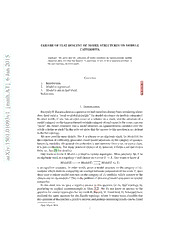
Failure of flat descent of model structures on module categories PDF
Preview Failure of flat descent of model structures on module categories
FAILURE OF FLAT DESCENT OF MODEL STRUCTURES ON MODULE CATEGORIES. 5 Abstract. Weprove that the collection of modelstructures on(quasicoherent) module 1 categoriesdoesnotobeyflatdescent. Inparticular, itfailstobeaseparatedpresheaf,in 0 thefppftopology,onArtinstacks. 2 n a J Contents 6 1. Introduction. 1 ] T 2. Modelasapresheaf. 2 A 3. Modelisnotanfppfsheaf. 2 References 4 . h t a m 1. Introduction. [ 1 RecentlyH.Bacardaskedusaquestionwehadourselvesalreadybeenwonderingabout: v doesthere exist a “local-to-globalprinciple” for modelstructures on modulecategories? 3 In other words, if one has an open cover of a scheme or a stack, and the structure of a 9 modelcategoryonthe(quasicoherent)modulecategoryofeachopeninthecover,canone 0 “paste” the modelstructures into a model structure on (quasicoherent)modulesover the 1 wholeschemeorstack?Inthisnoteweshowthattheanswertothisquestionisno,atleast 0 . intheflattopology. 1 We nowprovidemoredetails. For X aschemeoranalgebraicstack, let Model(X)be 0 5 thecollectionofcofibrantlygeneratedclosedmodelstructuresonthecategoryofquasico- 1 herentO -modules. (Ingeneralthiscollectionisnotknowntoformaset,orevenaclass; X : itisjustacollection. FormanypracticalchoicesofX,however,itformsasetandevena v i finiteset. See[5]fordetails.) X Onewantstoknowif Modelisasheafinvarioustopologies. Moreprecisely: letX be r analgebraicstackinatopologyτandchooseanτ-coverY →X. Onewantstoknowif a Model(X) // Model(Y) //// Model(Y×XY) isanequalizersequence. In otherwords, givena modelstructureonthecategoryofO - Y moduleswhichrestrictscompatiblyonoverlapsbetweencomponentsofthecoverY,does thereexistauniquemodelstructureonthecategoryofO -moduleswhichrestrictstothe X chosenoneonO -modules?Thisistheproblemofdescentofmodelstructuresonmodule Y categories. In thisshortnote we givea negativeanswer to this questionforthe fppftopology,by producing an explicit counterexample in Thm. 3.2. We do not know an answer to the questionforcoarsertopologiesbutwe(withH.Bacard,M.Frankland,D.Schaeppi)have exploredthe same question for the Zariski topology, where it seems more plausible that thisquestionofdescenthasapositiveanswer,andperhapsinterestingresultscanbefound Date:March2014. 1 2 FAILUREOFFLATDESCENTOFMODELSTRUCTURESONMODULECATEGORIES. in thatdirection. We are gratefulto J. F. Jardinefor hostingusduringa visit to Western University,wherethesequestionscameupinconversation. 2. Modelasapresheaf. Definition2.1. Letτbeoneofthefollowingtopologies:Zariski,e´tale,orfppf.LetXbean algebraicstackinthetopologyτandletAlgStacks (X)bethecategoryofalgebraicstacks τ Y intheτ-topologyequippedwithmapsY → X whicharecomponentsofsomecovering familyinτ. ForeveryobjectY ofAlgStacks (X),letModel(Y)bethecollectionofcofibrantlygen- τ eratedclosedmodelstructuresonthecategoryofquasicoherentO -modules. Y Foreverymap f : Y′ → Y inAlgStacks (X),let Model(f) : Model(Y) → Model(Y′) τ bethepartially-definedfunctionsendingamodelstructureonquasicoherentO -modules Y to the transfermodelstructure, if it exists, onquasicoherentOY′-modules, i.e., themodel structureinwhichamapg: M → N ofquasicoherentOY′-modulesisaweakequivalence (respectively,fibration)ifandonlyif f∗g: f∗M → f∗Nisaweakequivalence(respectively, fibration)inthegivenmodelstructureonquasicoherentO -modules. Y In the literature there is a small point of difference between variousdefinitions of al- gebraic stack: the issue is what condition one requiresof the diagonalmap. The reader canchoosewhateverdiagonalconditionstheylikebest,forthepurposesofDef.2.1. Our counterexample(in Thm.3.2) to fppfdescentof modelstructures, however,worksin all thedefinitionsoffppfalgebraicstackwhichareincommoncirculation,sinceinourcoun- terexamplealldiagonalmapsareaffine,hencealsoquasicompact,quasiseparated,etc. Thetransfermodelstructureexistsifandonlyif,foreverymorphismgofquasicoherent OY′-moduleswhichisatransfinitecompositeofpushoutsofcoproductsofmorphisms f∗h with h an acyclic cofibrationin the given modelstructure on O -modules, the morphism Y f∗g is a weak equivalencein the givenmodelstructure on OY-modules. This is a simple applicationofCrans’stheoremonexistenceoftransfermodelstructures,from[3]. The assumption that our model structures be cofibrantly generated is an unnecessary assumptioninmanysituationsofpracticalinterest.In[5]weshowthat,ifacategoryadmits a“saturatingbasis,” theneverymodelstructureonthatcategoryis cofibrantlygenerated. It then follows from the Cohen-Kaplansky theorem (from [2]) that, if R is an Artinian principalidealring,theneverymodelstructureonthecategoryofR-modulesiscofibrantly generated. We givemoreinformationandexplicitcomputationsin[5]. Itisprobablythe casethatverymanymodulecategorieshavethepropertythatalltheirmodelstructuresare cofibrantly generated. In any case, leaving out the adjectives “cofibrantly generated” or “closed,”orboth,fromDef.2.1doesnotdeterThm.3.2fromprovidingacounterexample toModelbeingasheaf. 3. Modelisnotanfppfsheaf. Definition3.1. Letk beafieldofcharacteristic2andletα bethealgebraicgroupover 2 kco-representedbytheHopfalgebrak[x]/x2with xprimitive. Thatis,α isthealgebraic 2 group given on affines by letting α (SpecR) be the group of square-zero elements of R, 2 underaddition. Let Bα be the (Artin) stack of α -torsors, i.e., the fppf algebraic stack associated to 2 2 the group(oid)affine scheme (Speck,Speck[x]/x2). We will write Speck → Bα for the 2 covernaturallyassociatedtothepresentationofBα givenbythegroupoidaffinescheme 2 FAILUREOFFLATDESCENTOFMODELSTRUCTURESONMODULECATEGORIES. 3 (Speck,Speck[x]/x2). Finally,let j , j denotethetwo(partially-defined)maps 1 2 // Model(Speck) // Model(Speck×Bα2 Speck) andletidenotethe(partially-defined)map Model(Bα )→ Model(Speck). 2 Theorem3.2. Thereexisttwodistinctelementsa,binModel(Bα )suchthat: 2 • i(a)andi(b)arewell-defined, • i(a)=i(b), • and j (i(a))and j (i(a))arewell-defined(andconsequently j (i(a))= j (i(a)). 1 2 1 2 Consequently, even if Model is a well-definedpresheaf, it is not a separatedpresheaf in thefppftopology,hencenotasheafinthefppftopology. Proof. We first define the model structures a,b on quasicoherentO -modules. By the Bα2 usualdescentargument,quasicoherentO -modulesareequivalenttok[x]/x2-comodules. Bα2 First,adefinition:supposeMisarightk[x]/x2-comodulewithstructuremapψ: M → M⊗ k[x]/x2. WesaythatMisx-trivialifthecompositemap k M (idM−⊗→kη)−ψ M⊗ k[x]/x2 id−M→⊗kǫ M⊗ k k k iszero,whereηistheunitmapη:k →k[x]/x2. Inotherwords, Mis x-trivialifandonly if,forallm∈ M,ψ(m)hasnononzerotermsinvolvingx. Notethateveryrightk[x]/x2-comoduleMhasamaximalx-trivialsubcomoduletriv(M), andthattheinclusiontriv(M)→ Mexpressesthex-trivialcomodulesasacoreflectivesub- categoryofthecategoryofk[x]/x2-comodules. Letmodelstructureaonthe categoryofk[x]/x2-comodulesbethe modelstructurein which: • thecofibrationsarethepushoutsofmapsbetweenx-trivialcomodules, • the weak equivalences are the maps inducing an isomorphism on the maximal x-trivialsubcomodules, • andallmapsarefibrations. In [1] (also, more directly, in our [4]) the necessary results on factorization systems are provento ensure that, if C is an categorywith finite limits and colimits and A is a core- flective replete subcategory of C, then there exists a model structure on C in which the cofibrationsarethepushoutsofmapsbetweenobjectsinA,theweakequivalencesarethe mapsinducinganisomorphismonapplyingthecoreflectorfunctor,andallmapsarefibra- tions. Our model structure a is the special case of this theorem where A consists of the x-trivialcomodules. Letmodelstructurebonthecategoryofk[x]/x2-comodulesbethediscretemodelstruc- ture,i.e.,themodelstructureinwhich: • allmapsarecofibrations, • theweakequivalencesaretheisomorphisms, • andallmapsarefibrations. We claim thati(a)and i(b)bothexist andin fact are eachequalto the discrete model structureonthecategoryofk-modules. Indeed,undertheidentificationofquasicoherent O -modules with k[x]/x2-comodules, we have the standard identification of the direct Bα2 f imageandinverseimagefunctorsintermsofcomodules:themapofstacksSpeck −→ Bα 2 inducesthedirectimagefunctor f∗ :Mod(k)→Comod(k[x]/x2) 4 FAILUREOFFLATDESCENTOFMODELSTRUCTURESONMODULECATEGORIES. sending a k-module M to the extended comodule M ⊗ k[x]/x2, and the inverse image k functor f∗ :Comod(k[x]/x2)→Mod(k) sendingak[x]/x2-comoduletoitsunderlyingk-module,i.e.,forgettingthecoactionmap. So in the transfermodelstructurei(a) onk-modules, a morphismg is a weak equiva- lence if and only if g⊗ k[x]/x2 is a weak equivalencein a. But this implies g must be k an isomorphism, since the map induced by g⊗ k[x]/x2 on the maximal x-trivialsubco- k modulesisgitself. Hencetheweakequivalencesini(a)arethesameasthediscreteweak equivalences.Thesameistriviallytrueforfibrations. Sincebisthediscretemodelstructureonk[x]/x2-comodules,itistriviallytruethatthe weak equivalencesand fibrationsin i(b) agree with those of the discrete modelstructure onk-modules. Consequentlyi(a) andi(b) both existand are equalto the discrete modelstructureon k-modules. Nowallthatremainsistoshowthat j (i(a))and j (i(a))bothexist. Thattheyareequal 1 2 if they exist is trivial (for example, because j = j in this setting, since k[x]/x2 is a 1 2 HopfalgebraandnotonlyaHopfalgebroid!). Themodelstructure j (i(a))isthediscrete 1 model structure on k-modules transferred to quasicoherent OSpeck×Bα2Speck (cid:27) OSpeck[x]/x2- modules, i.e., k[x]/x2-modules, along the direct image map, i.e., restriction of scalars. So a morphism g of k[x]/x2-modules is a weak equivalence in j (i(a)) if and only if its 1 underlying map of k-modules is a weak equivalence in i(a), i.e., if and only if g is an isomorphism. Similarly,amorphismgofk[x]/x2-modulesisafibrationin j (i(a))ifand 1 only if its underlying map of k-modules is a fibration in i(a), i.e., all morphisms g of k[x]/x2-modulesarefibrations. Hencetheweakequivalencesandthefibrationsin j (i(a)) 1 eachagreewiththoseinthediscretemodelstructureonk[x]/x2-modules.Hence j (i(a))= 1 j (i(a))= j (i(b))= j (i(b))existsandisthediscretemodelstructureonk[x]/x2-modules. 2 1 2 (cid:3) References [1] C.Cassidy,M.He´bert,andG.M.Kelly.Reflectivesubcategories,localizationsandfactorizationsystems.J. Austral.Math.Soc.Ser.A,38(3):287–329,1985. [2] I.S.CohenandI.Kaplansky.Ringsforwhicheverymoduleisadirectsumofcyclicmodules.Math.Z., 54:97–101,1951. [3] SjoerdE.Crans.Quillenclosedmodelstructuresforsheaves.J.PureAppl.Algebra,101(1):35–57,1995. [4] AndrewSalch.Theclosedunitballinthespaceofmodelstructuresonacategory.availableonarXiv. [5] AndrewSalch.Computingallclosedmodelstructuresonagivencategory.inpreparation.
